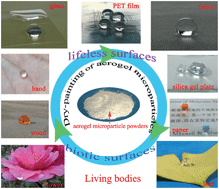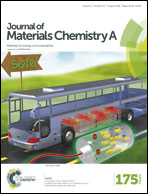Reversible superhydrophobic coatings on lifeless and biotic surfaces via dry-painting of aerogel microparticles†
Abstract
The superhydrophobicity of living bodies such as lotus leaves, butterfly wings, and water strider legs has its own physiological meaning and it is critical for the survival of these lives. Although great progress has been achieved in superhydrophobic modification on a variety of substrates, such as glass, silicon wafer, and fabric, which are all lifeless objects, it is a great challenge for the superhydrophobic modification of living creatures. In this work, strategies to fulfill the vision are proposed by synthesis of a series of biocompatible silica aerogel microparticles via a solvent-exchange-free and ambient pressure drying process. Then, dry-painting of the aerogel microparticles directly on various surfaces is developed. Interestingly, the results indicate that the silica aerogel microparticles can not only be successfully applied to various lifeless surfaces (e.g., glass, paper, and polymers), but also be used on biotic surfaces of living bodies (e.g., leaves, flowers, and skin). Moreover, these superhydrophobic coatings are mechanically stable but could be easily removed on demand by simple methods due to the non-covalent bonding between the aerogel and the substrates. Ultimately, an “invisible glove” is also demonstrated by the fact that nothing is hurt after dipping hands daubed with the SHB-SAMPs into highly corrosive aqueous liquids, e.g., 1 M HCl and 1 M NaOH.


 Please wait while we load your content...
Please wait while we load your content...